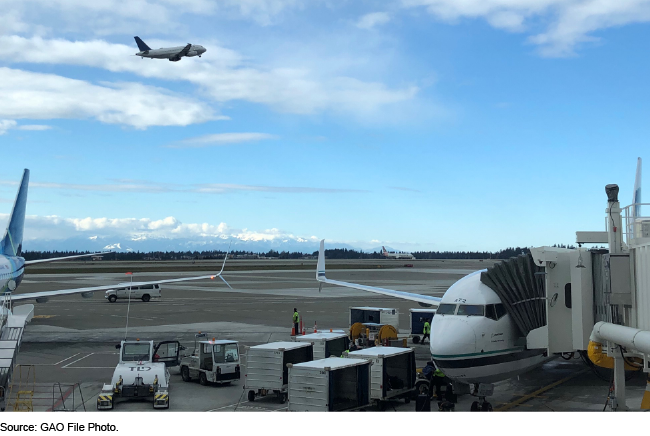Aircraft Noise: Information on a Potential Mandated Transition to Quieter Airplanes
Fast Facts
Although advances in technology have led to quieter aircraft, airport noise remains a concern.
We found that while the noise certifications for most U.S.-based large commercial jet airplanes are for the minimum noise standards, nearly all of them (96%) are able to meet more stringent noise standards. This is primarily because aircraft technology has outpaced the implementation of noise standards.
However, according to stakeholders we interviewed, requiring the airplanes to go through the recertification process for more stringent noise standards could be costly and would provide little noise reduction.

Highlights
What GAO Found
Based on Federal Aviation Administration (FAA) data and GAO estimates, most U.S. large commercial jet airplanes are certificated at the minimum required stage 3 noise standards, but nearly all of them are able to meet more stringent noise standards. Sixty-three percent of large commercial airplanes in the United States are certificated as meeting the stage 3 standards; however, 87 percent of them were manufactured with technologies that are able to meet more recent and stringent stage 4 or 5 standards as currently configured, according to FAA's 2017 analysis. By analyzing updated data from airlines and aviation manufacturers, GAO estimated that this proportion is even higher: 96 percent of large commercial airplanes are able to meet stage 4 or 5 standards (see figure). According to FAA officials and aviation stakeholders, the primary reason many large commercial airplanes certificated as stage 3 produce lower than stage 3 noise levels is because engine and airframe technology has outpaced the implementation of noise standards. More recently, some airlines have accelerated retirement of certain airplanes, some of which are certificated as stage 3, due to the decrease in travel amid the COVID-19 pandemic. For the generally smaller regional commercial jets (i.e., generally with less than 90 seats), 86 percent are able to meet stage 4 or stage 5 standards, according to manufacturers' data. With regard to general aviation (which are used for personal or corporate flights), 73 percent of the jet airplanes in that fleet are able to meet the more stringent stage 4 or 5 standards, according to manufacturers' data.
GAO Estimate of The Number of Large Airplanes in the U.S. Commercial Fleet That Are Able to Meet Stage 3 or Stage 4 and 5 Noise Standards, January 2020

According to stakeholders GAO interviewed, a phase-out of jet airplanes that are certificated as meeting stage 3 standards would provide limited noise reduction and limited other benefits, and could be costly and present other challenges. A phase-out could require recertificating the vast majority of stage 3 airplanes to comply with stage 4 or 5 standards. This process could be costly for operators and manufacturers but would provide little reduction in noise. Further, airplanes currently unable to meet more stringent standards would require modifications or face retirement. For older airplanes that could not be recertificated to meet stage 4 or 5 standards, some operators could incur costs for replacement airplanes sooner than originally planned. Although stakeholders indicated that a phase-out would not substantially reduce noise, they identified other limited benefits newer airplanes generate, such as reduced greenhouse gas emissions and fuel consumption.
Why GAO Did This Study
Although advances in technology have led to quieter aircraft capable of meeting increasingly stringent noise standards, airport noise remains a concern. FAA regulates aircraft noise by ensuring compliance with relevant noise standards. In 1990, federal law required large jet airplanes to comply with stage 3 noise standards by 1999, leading to a phase-out of the noisiest airplanes (stage 1 and 2 airplanes). Later, federal law required smaller airplanes to comply with stage 3 standards by 2016.
The FAA Reauthorization Act of 2018 included a provision for GAO to review a potential phase-out of stage 3 airplanes—the loudest aircraft currently operating in the United States. This report describes (1) the proportion of stage 3 airplanes in the U.S. fleet, and what proportion of these stage 3 airplanes are able to meet more stringent noise standards and (2) selected stakeholders' views on the potential benefits, costs, and challenges of phasing out stage 3 airplanes.
GAO reviewed FAA's analysis of December 2017 fleet data, analyzed January 2020 fleet data from select airlines and airframe and engine manufacturers, and interviewed FAA officials. GAO also interviewed a non-generalizable sample of 35 stakeholders, including airlines; airframe and engine manufacturers; airports; and industry associations, selected based on fleet and noise data, stakeholder recommendations, or prior GAO knowledge.
For more information, contact Heather Krause at (202) 512-2834 or krauseh@gao.gov.
